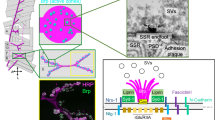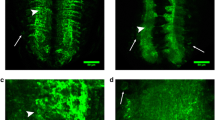Abstract
Synapses are specialized junctions between cells that mediate neurotransmission to modify brain activity and body function. Studies on synapse structure and function play an important role in understanding how neurons communicate and the consequences of their dysfunction in neurological disorders. The Drosophila larval neuromuscular junction is an excellent model for dissecting the cellular and molecular mechanisms of the synapse, with its large size, accessibility, and well-characterized genetics. This protocol describes the steps required for morphological and immunohistochemical analysis of the Drosophila larval neuromuscular junction including its dissection and multiplex labeling of synaptic proteins. This technique can be used to assess the impact of genetic manipulations on synaptic development, integrity, and plasticity, thus providing a valuable tool for probing complex neurological processes in a whole animal system.
Access this chapter
Tax calculation will be finalised at checkout
Purchases are for personal use only
Similar content being viewed by others
References
Ziegler AB et al (2016) The amino acid transporter JhI-21 coevolves with glutamate receptors, impacts NMJ physiology, and influences locomotor activity in drosophila larvae. Sci Rep 6. https://doi.org/10.1038/srep19692
Thomas U, Kobler O, Gundelfinger ED (2010) The drosophila larval neuromuscular junction as a model for scaffold complexes at glutamatergic synapses: benefits and limitations. J Neurogenet 24:109–119. https://doi.org/10.3109/01677063.2010.493589
Prokop A (2006) Organization of the efferent system and structure of neuromuscular junctions in Drosophila. Int Rev Neurobiol 75:71–90. https://doi.org/10.1016/s0074-7742(06)75004-8
Menon KP, Carrillo RA, Zinn K (2013) Development and plasticity of the Drosophila larval neuromuscular junction. Wiley Interdiscip Rev Dev Biol 2:647–670. https://doi.org/10.1002/wdev.108
Marrus SB, Portman SL, Allen MJ, Moffat KG, DiAntonio A (2004) Differential localization of glutamate receptor subunits at the Drosophila neuromuscular junction. J Neurosci 24:1406–1415. https://doi.org/10.1523/jneurosci.1575-03.2004
Hoang B, Chiba A (2001) Single-cell analysis of Drosophila larval neuromuscular synapses. Dev Biol 229:55–70
Miyazaki T et al (2021) Excitatory and inhibitory receptors utilize distinct post- and trans-synaptic mechanisms in vivo. eLife 10:e59613. https://doi.org/10.7554/eLife.59613
Ruiz-Cañada C, Budnik V (2006) Synaptic cytoskeleton at the neuromuscular junction. Int Rev Neurobiol 75:217–236. https://doi.org/10.1016/s0074-7742(06)75010-3
Chou VT, Johnson SA, Van Vactor D (2020) Synapse development and maturation at the drosophila neuromuscular junction. Neural Dev 15:11. https://doi.org/10.1186/s13064-020-00147-5
Miller DL, Ballard SL, Ganetzky B (2012) Analysis of synaptic growth and function in Drosophila with an extended larval stage. J Neurosci 32:13776–13786. https://doi.org/10.1523/jneurosci.0508-12.2012
Wagh DA et al (2006) Bruchpilot, a protein with homology to ELKS/CAST, is required for structural integrity and function of synaptic active zones in Drosophila. Neuron 49:833–844. https://doi.org/10.1016/j.neuron.2006.02.008
Stogsdill JA, Harwell CC, Goldman SA (2023) Astrocytes as master modulators of neural networks: synaptic functions and disease-associated dysfunction of astrocytes. Ann N Y Acad Sci. https://doi.org/10.1111/nyas.15004
Xing G et al (2018) Neurexin-Neuroligin 1 regulates synaptic morphology and functions via the WAVE regulatory complex in Drosophila neuromuscular junction. eLife 7. https://doi.org/10.7554/eLife.30457
Marqués G et al (2002) The Drosophila BMP type II receptor wishful thinking regulates neuromuscular synapse morphology and function. Neuron 33:529–543
Wan HI et al (2000) Highwire regulates synaptic growth in Drosophila. Neuron 26:313–329
Budnik V (1996) Synapse maturation and structural plasticity at Drosophila neuromuscular junctions. Curr Opin Neurobiol 6:858–867. https://doi.org/10.1016/s0959-4388(96)80038-9
Guangming G, Junhua G, Chenchen Z, Yang M, Wei X (2020) Neurexin and neuroligins maintain the balance of ghost and satellite boutons at the drosophila neuromuscular junction. Front Neuroanat 14:19. https://doi.org/10.3389/fnana.2020.00019
Eaton BA, Davis GW (2003) Synapse disassembly. Genes Dev 17:2075–2082
Sutcliffe B, Forero MG, Zhu B, Robinson IM, Hidalgo A (2013) Neuron-type specific functions of DNT1, DNT2 and Spz at the Drosophila neuromuscular junction. PLoS One 8:e75902. https://doi.org/10.1371/journal.pone.0075902
Pielage J, Fetter RD, Davis GW (2005) Presynaptic spectrin is essential for synapse stabilization. Curr Biol 15:918–928
Koch I et al (2008) Drosophila ankyrin 2 is required for synaptic stability. Neuron 58:210–222
Ramachandran P, Barria R, Ashley J, Budnik V (2009) A critical step for postsynaptic F-actin organization: regulation of Baz/Par-3 localization by aPKC and PTEN. Dev Neurobiol 69:583–602. https://doi.org/10.1002/dneu.20728
Author information
Authors and Affiliations
Corresponding author
Editor information
Editors and Affiliations
Rights and permissions
Copyright information
© 2024 The Author(s), under exclusive license to Springer Science+Business Media, LLC, part of Springer Nature
About this protocol
Cite this protocol
Sun, Y., Zhao, Y., Johnson, T.K., Xie, W. (2024). Immunohistochemical Analysis of the Drosophila Larval Neuromuscular Junction. In: Dworkin, S. (eds) Neurobiology. Methods in Molecular Biology, vol 2746. Humana, New York, NY. https://doi.org/10.1007/978-1-0716-3585-8_16
Download citation
DOI: https://doi.org/10.1007/978-1-0716-3585-8_16
Published:
Publisher Name: Humana, New York, NY
Print ISBN: 978-1-0716-3584-1
Online ISBN: 978-1-0716-3585-8
eBook Packages: Springer Protocols




